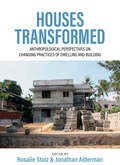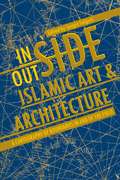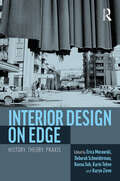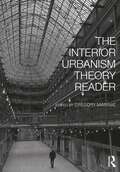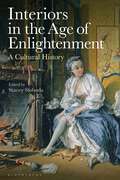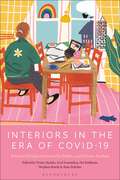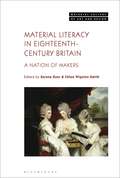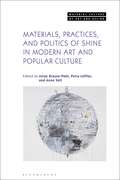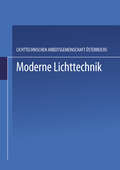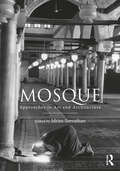- Table View
- List View
Door Key (UEB Contracted)
This picture is of a door key. There is a locator dot shown, which will be at the top left of the page when the image is the right way up. At the top is the handle of the key with a hole in it, and at the bottom is the part of the key that goes into the lock. On the left side of this are the pointed teeth and there is a groove going down to the right.
Door Key (UEB Uncontracted)
This picture is of a door key. There is a locator dot shown, which will be at the top left of the page when the image is the right way up. At the top is the handle of the key with a hole in it, and at the bottom is the part of the key that goes into the lock. On the left side of this are the pointed teeth and there is a groove going down to the right.
Houses Transformed: Anthropological Perspectives on Changing Practices of Dwelling and Building
Over the decades, there has been a world-wide transformation of so-called ‘vernacular houses’. Based on ethnographic accounts from different regions, Houses Transformed investigates the changing practices of building houses in a transnational context. It explores the intersection of house biographies and social change, the politics of housing design, the social fabrication of aspirational houses, the domestication of concrete and the intersection of materiality and ontology as well as the rhetoric of the vernacular. The volume provides new anthropological pathways to understanding the dynamics of dwelling in the 21st century.
Igloo (Large Print)
This image shows an igloo from the front. There is a locator dot shown, which will be at the top left of the page when the image is the right way up. The igloo is a dome-shaped structure and fills the page. It is constructed of rectangular blocks of ice fitted together in offset layers like house bricks. The arched entrance is at the end of a short rounded tunnel, and is shown at the lower centre of the image.
Igloo (UEB Contracted)
This image shows an igloo from the front. There is a locator dot shown, which will be at the top left of the page when the image is the right way up. The igloo is a dome-shaped structure and fills the page. It is constructed of rectangular blocks of ice fitted together in offset layers like house bricks. The arched entrance is at the end of a short rounded tunnel, and is shown at the lower centre of the image.
Igloo (UEB uncontracted)
This image shows an igloo from the front. There is a locator dot shown, which will be at the top left of the page when the image is the right way up. The igloo is a dome-shaped structure and fills the page. It is constructed of rectangular blocks of ice fitted together in offset layers like house bricks. The arched entrance is at the end of a short rounded tunnel, and is shown at the lower centre of the image.
Inside/Outside Islamic Art and Architecture: A Cartography of Boundaries in and of the Field
When we walk into a gallery, we have a fairly good idea where the building begins and ends; and inside, while observing a painting, we are equally confident in distinguishing between the painting-proper and its frame and borders. Yet, things are often more complicated. A building defines an exterior space just as much as an interior, and what we perceive to be ornamental and marginal to a given painting may in fact be central to what it represents. In this volume, a simple question is presented: instead of dichotomous separations between inside and outside, or exterior and interior, what other relationships can we think of?The first book of its kind to grapple with this question, Inside/Outside Islamic Art and Architecture focuses on a wide spectrum of mediums and topics, including painted manuscripts, objects, architectural decoration, architecture and urban planning, and photography. Bringing together scholars with diverse methodologies-who work on a geographical span stretching from India to Spain and Nigeria, and across a temporal spectrum from the thirteenth to the twenty-first century-this original book also poses engaging questions about the boundaries of the field.
Interior Design on Edge: History, Theory, Praxis
Interior Design on Edge explores ways that interiors both constitute and upset our edges, whether physical, conceptual or psychological, imagined, implied, necessary or discriminatory.The essays in this volume explore these questions in history, theory, and praxis through a focus on different periods, cultures, and places. Interior Design on Edge showcases new scholarship that expands and contests traditional relationships between architecture, interiors, and the people that use and design them, provoking readers to consider the interior differently, moving beyond its traditional, architectural definition. Focusing on the concept of interiority considered in a wider sense, it draws on interdisciplinary modes of investigation and analysis and reflects the latest theoretical developments in the fields of interior design history and practice.With new research from both established and emerging authors, this volume will make a valuable contribution to the fields of Interior Design, Architecture, Art and Design History, Cultural History, Visual Culture Studies, and Urban Studies.
The Interior Urbanism Theory Reader
The Interior Urbanism Theory Reader expands our understanding of urbanism, interiority, and publicness from a global perspective across time and cultures. From ancient origins to speculative futures, this book explores the rich complexities of interior urbanism as an interstitial socio-spatial condition. Employing an interdisciplinary lens, it examines the intersectional characteristics that define interior urbanism. Fifty chapters investigate the topic in relation to architecture, planning, urban design, interior architecture, interior design, archaeology, engineering, sociology, psychology, and geography. Individual essays reveal the historical, typological, and morphological origins of interior urbanism, as well as its diverse scales, occupancies, and atmospheres. The Interior Urbanism Theory Reader will appeal to scholars, practitioners, students, and enthusiasts of urbanism, architecture, planning, interiors, and the social sciences.
Interiors in the Age of Enlightenment: A Cultural History
Interiors in the Age of Enlightenment provides a comprehensive and interdisciplinary overview of the cultural history of interior design and interior spaces from 1700 to 1850.Considering the interior as material, social and cultural artefact, this volume moves beyond conventional descriptive accounts of changing styles and interior design fashions, to explore in depth the effect on the interior of the materials, processes, aesthetic philosophies and cultural attitudes of the age.From the Palace of Versailles to Virginia coffeehouses, and from Chinoiserie bathhouses to the trading exchanges of the West Indies, the chapters in this book examine a wide range of themes including technological advancements, public spaces, gender and sexuality, and global movements in interior designs and decorations. Drawing together contributions from leading scholars, this volume provides the most authoritative and comprehensive survey of the history of interiors and interior architecture in the long eighteenth century.
Interiors in the Era of Covid-19: Interior Design between the Public and Private Realms
The Covid-19 lockdowns caused people worldwide to be confined to their homes for longer and on a greater scale than ever before. This forced many unprecedented changes to the way we treat domestic space – as relationships shifted between the public and the private worlds, and homes were rapidly adapted to accommodate the additional roles of schools, offices, gyms, restaurants, making-spaces and more. Above all, our understanding of the home as a site to support and enhance the well-being of its inhabitants changed in a variety of novel ways. Interiors in the Era of Covid is a collection of essays which explore the complex ways in which our inside spaces (contemporary and historical) have responded to Covid-19 and other human crises. With case studies ranging from US and Europe to Japan, China, Colombia, and Bangladesh, this is a truly global work which examines wide-ranging subjects from home-working and home technologies, to the impact of lockdown on people's identities, gender roles in the home, and the realities of domestic living with Covid in refugee camps. Exploring the roles played by designers (both amateur and professional) in accommodating changing requirements and anticipating future ones – whether Covid or beyond – this book is a must-read for students and researchers in interior design, architecture, architectural and design history, and anyone interested in the home and the relationships between health and design.
Lit match and box of matches (Large Print)
This image shows a match that has been lit and a box with matches in it. There is a locator dot shown, which will be at the top left of the page when the image is the correct way up. The lit match is at the top of the page. The box with matches is at the bottom of the page. The match heads are on the right in the box. Only the top of the matches can be found. Test your tactile skills: - Can you find the flame of the lit match - How many matches are there in the box?
Lit match and box of matches (UEB Contracted)
This image shows a match that has been lit and a box with matches in it. There is a locator dot shown, which will be at the top left of the page when the image is the correct way up. The lit match is at the top of the page. The box with matches is at the bottom of the page. The match heads are on the right in the box. Only the top of the matches can be found. Test your tactile skills: - Can you find the flame of the lit match - How many matches are there in the box?
Lit match and box of matches (UEB Uncontracted)
This image shows a match that has been lit and a box with matches in it. There is a locator dot shown, which will be at the top left of the page when the image is the correct way up. The lit match is at the top of the page. The box with matches is at the bottom of the page. The match heads are on the right in the box. Only the top of the matches can be found. Test your tactile skills: - Can you find the flame of the lit match - How many matches are there in the box?
Log Cabin (Large Print)
This image shows a gable wall view of a cabin constructed from logs. There is a locator dot shown which will be at the top left of the page when the image is the right way up. The pointed roof fills the top half of the page. The rounded ends of the supporting logs are shown down from the two sloping surfaces of the roof. On the right side of the image there is a crooked chimney sticking out from the roof. Down from the roof is the wall of the cabin. Here the rounded ends of the logs making up the side walls are shown at the left and right edges of the image, and these interleave with the slightly irregular length logs making up the wall shown. In the centre of this wall is a wooden door with a large door knob and ledges above and below it. At each side of the door there is a window with wooden ledges to top and bottom.
Log Cabin (UEB Contracted)
This image shows a gable wall view of a cabin constructed from logs. There is a locator dot shown which will be at the top left of the page when the image is the right way up. The pointed roof fills the top half of the page. The rounded ends of the supporting logs are shown down from the two sloping surfaces of the roof. On the right side of the image there is a crooked chimney sticking out from the roof. Down from the roof is the wall of the cabin. Here the rounded ends of the logs making up the side walls are shown at the left and right edges of the image, and these interleave with the slightly irregular length logs making up the wall shown. In the centre of this wall is a wooden door with a large door knob and ledges above and below it. At each side of the door there is a window with wooden ledges to top and bottom.
Log Cabin (UEB uncontracted)
This image shows a gable wall view of a cabin constructed from logs. There is a locator dot shown which will be at the top left of the page when the image is the right way up. The pointed roof fills the top half of the page. The rounded ends of the supporting logs are shown down from the two sloping surfaces of the roof. On the right side of the image there is a crooked chimney sticking out from the roof. Down from the roof is the wall of the cabin. Here the rounded ends of the logs making up the side walls are shown at the left and right edges of the image, and these interleave with the slightly irregular length logs making up the wall shown. In the centre of this wall is a wooden door with a large door knob and ledges above and below it. At each side of the door there is a window with wooden ledges to top and bottom.
Male Lion (Large Print)
Here is a picture of a lion with his body shown from the side. There is a locator dot shown, which will be at the top left of the page when the image is the right way up. His head is at the left centre facing you, with two ears, two eyes, nose and mouth. The lion has a mane of thick long hair around his head. Lower down the page are the lion's two front legs, and to the right its back legs, all with long claws on the feet. At the right of the lion's body is its tail with a furry end.
Male Lion (UEB Contracted)
Here is a picture of a lion with his body shown from the side. There is a locator dot shown, which will be at the top left of the page when the image is the right way up. His head is at the left centre facing you, with two ears, two eyes, nose and mouth. The lion has a mane of thick long hair around his head. Lower down the page are the lion's two front legs, and to the right its back legs, all with long claws on the feet. At the right of the lion's body is its tail with a furry end.
Male Lion (UEB uncontracted)
Here is a picture of a lion with his body shown from the side. There is a locator dot shown, which will be at the top left of the page when the image is the right way up. His head is at the left centre facing you, with two ears, two eyes, nose and mouth. The lion has a mane of thick long hair around his head. Lower down the page are the lion's two front legs, and to the right its back legs, all with long claws on the feet. At the right of the lion's body is its tail with a furry end.
Material Literacy in Eighteenth-Century Britain: A Nation of Makers (Material Culture of Art and Design)
The eighteenth century has been hailed for its revolution in consumer culture, but Material Literacy in Eighteenth-Century Britain repositions Britain as a nation of makers. It brings new attention to eighteenth-century craftswomen and men with its focus on the material knowledge possessed not only by professional artisans and amateur makers, but also by skilled consumers. This edited collection gathers together a group of interdisciplinary scholars working in the fields of art history, history, literature, and museum studies to unearth the tactile and tacit knowledge that underpinned fashion, tailoring, and textile production. It invites us into the workshops, drawing rooms, and backrooms of a broad range of creators, and uncovers how production and tacit knowledge extended beyond the factories and machines which dominate industrial histories. This book illuminates, for the first time, the material literacies learnt, enacted, and understood by British producers and consumers. The skills required for sewing, embroidering, and the textile arts were possessed by a large proportion of the British population: men, women and children, professional and amateur alike. Building on previous studies of shoppers and consumption in the period, as well as narratives of manufacture, these essays document the multiplicity of small producers behind Britain's consumer revolution, reshaping our understanding of the dynamics between making and objects, consumption and production. It demonstrates how material knowledge formed an essential part of daily life for eighteenth-century Britons. Craft technique, practice, and production, the contributors show, constituted forms of tactile languages that joined makers together, whether they produced objects for profit or pleasure.
Materials, Practices, and Politics of Shine in Modern Art and Popular Culture (Material Culture of Art and Design)
Shine allures and awakens desire. As a phenomenon of perception shiny things and materials fascinate and tantalize. They are a formative element of material culture, promising luxury, social distinction and the hope of limitless experience and excess. Since the early twentieth century the mass production, dissemination and popularization of synthetic materials that produce heretofore-unknown effects of shine have increased. At the same time, shine is subjectified as “glamor” and made into a token of performative self-empowerment. The volume illuminates genealogical as well as systematic relationships between material phenomena of shine and cultural-philosophical concepts of appearance, illusion, distraction and glare in bringing together renowned scholars from various disciplines.
Mosque: Approaches to Art and Architecture
Mosque examines the history, culture, evolution and functions of the Muslim house of worship through the prism of its artistic objects and architectural elements. Contributors present a range of elements, from dome to mihrab, to mosque furniture including lamps, prayer rugs and Qur’an stands. In addition, the book draws attention to the importance of mosque heritage through special projects and initiatives that study, preserve and revitalize the traditional arts of the mosque. This unique book brings together prominent architects, art historians, artists, historians and curators to explore innovative approaches towards the study of mosques through the presentation of original research and insights about mosque-related cultural objects. It is essential reading for anyone interested in the art and culture of the Muslim world.
Mushroom (Large Print)
This is an image of an open-cap mushroom in the middle of the page. The mushroom is the fruiting body of a type of fungus. There is a locator dot shown, which will be at the top left of the page when the image is the correct way up. The mushrooms cap is at the top of the image. It is a warm grey in colour. Down the page from the cap, are the mushrooms gills (lamellae), they are represented as lines radiating from the top of the stem (stipe), which is further down the page. The dark brown lamellae produce spores that will grow into new fungi. The stipe extends down the page and at its bottom it would connect to a network of fine root-like hairs through which the organism absorbs its nutrition. These hairs have not been shown on the diagram.

